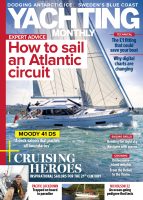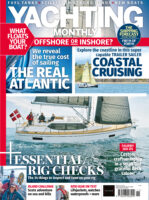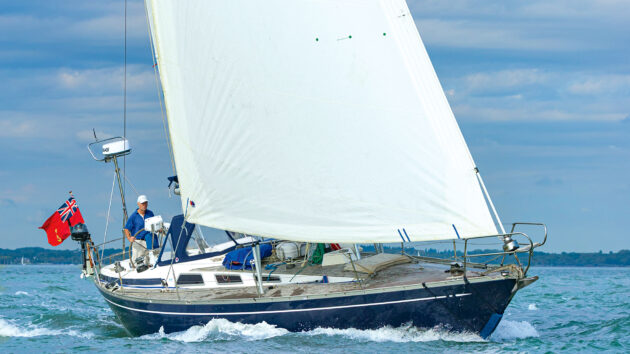Sparkman & Stephens’ Swan 38 from the 1970s is known as one of the all-time classic cruiser-racers for good reason, as David Harding discovers
Swan 38 used boat review: A stunning reputation for a reason
The Swan 38 os the sort of boat that has such a reputation you can feel almost daunted by the prospect of sailing one, let alone writing about it.
If boats like this are as good as they’re cracked up to be, you might simply find yourself repeating things that have been said before, over years or even decades. And if they’re not? Do you risk invoking the wrath of diehard enthusiasts who won’t hear a word said against them?
Thankfully, any concerns I might have had on this score didn’t stop me accepting an invitation to sail with Donald Begg on his Swan 38. After all, the Swan 38 is one of those boats that you just have to sail during your lifetime, in the same way that you have to sail the S&S 34 and Contessa 32.
With some of these boats, you can take the approach that most of what has been written about them was written a long time ago, and that what applied then might not be seen as quite so relevant today. Reputations are reputations nonetheless, and the fashions of the day play no part in the way the sea treats the boats that sail on it.
To today’s younger boat show visitors especially, a boat like the Swan 38 might seem irrelevant and outdated. Compared with a typical modern 38-footer, she’s dark and cramped below decks. She’s not as fast or even as steady downwind in a breeze, and that enormous foretriangle is going to call for some serious winching every time you tack.
Then you have that high, up-and-over bridgedeck that means you have to – well, climb up and over it to go down below.
You can understand all this being quite perplexing to a newcomer, who might look at you blankly and ask: ‘What’s so special about the Swan 38?’

One of the most distinctively graceful boats afloat, the Swan 38 is a fine all-round performer. Photo: David Harding / sailingscenes.com
Traditional values
Your answer might be that if anyone has to ask, they’re not ready for a Swan 38. This is a boat that’s unlikely to be bought by someone new to sailing and planning to go marina-hopping around the coast. That might be seen as a waste of the Swan and, besides, there are plenty of alternatives better suited to that sort of use.
Boats such as the Swan 38 tend to be bought by people with hard-earned sea miles under their belts, who want to be able to go anywhere and who appreciate that the Swan is the type of boat that will look after them come what may.
In that respect, Donald Begg fits the ‘owner profile’ perfectly. Donald’s previous boat was a Bowman 48, in which he sailed around the world between 2014 and 2020. He joined the World ARC for some legs, sailed independently on others, and left the boat periodically to come home in-between.
Earlier in his sailing career, Donald sailed a Condor 37, designed (like the Swan) by Sparkman & Stephens, built in Penryn and remarkably similar to the Swan 38. That’s not why he bought the Swan, however.
‘After the circumnavigation, I sold the Bowman, thinking I had completed my long-distance sailing,’ he told me. His plan was to buy a smaller boat ‘to keep me entertained in local waters’.
Article continues below…
Contessa 32: A brand new classic
Theo Stocker visits the Jeremy Rogers yard to see the latest Contessa 32 take shape
1979 Fastnet Race: The race that changed everything
Nic Compton investigates how the UK’s worst sailing disaster - the 1979 Fastnet Race - changed the way yachts are…
At the top of his list was the Rustler 36, but this was shortly after Covid and both examples he had his eye on were snapped up. Then his attention was drawn to a Sweden Yachts 42, before he found the Swan advertised on the Hamble. As he explained: ‘My criterion was a boat that would have survived the 1979 Fastnet.’
As it happens, a Swan 38 did survive the 1979 Fastnet, and that very boat is still winning races today. So Donald’s faith in the design was well placed. ‘I spent some money on Ellida, took her sailing, and enjoyed it so much that I kept going.’
Over the past four years he has sailed her from his base in Lymington to the Faroes, the Shetlands, Norway, the Dutch canals, Brittany, Portugal and the Azores.
That’s what happens when you have a boat like the Swan: she likes sailing, and makes you want to carry on. Why? It’s the S&S (Sparkman & Stephens) magic, which her designers certainly worked into the 38.

Fine forward sections, a narrow waterline and deep canoe body all help to give the Swan 38 an easy motion in a seaway. Photo: David Harding / sailingscenes.com
She possesses qualities that make for a fast, stiff, powerful, smooth and comfortable boat. She has a hull of modest beam with moderate freeboard and a relatively small wetted area, paired with a lead keel that accounts for nearly 40% of her weight, and a good spread of sail.
Her fine forward sections are a soft elliptical shape, giving her a notably easy motion upwind in a seaway. The relatively narrow waterline and deep canoe body are further contributory factors.
Like all Swans of this era, she has a tree trunk for a mast and a tall masthead rig with a large foretriangle.
It’s well-known that the Swan 38 is a wizard to windward, especially when the wind and sea pick up. She carries her canvas, points high and goes fast while boats all around are running out of power, shortening sail, slamming and banging and making life miserable for their crews. The price you pay on the Swan is getting wet. You can’t have it all ways.

Narrow by modern standards, the cockpit is secure in heavy weather and works well for both cruising and racing crews. Photo: David Harding / sailingscenes.com
Qualities and compromises
The other trade-off is downwind in a breeze, when the narrow stern – a common feature during the IOR (International Offshore Rule) era – means that she reaches displacement speed and then starts to dig a hole in the water. She will surf in the right conditions, of course. Otherwise, don’t expect more than about 8 knots.
This hull shape, combined with a large masthead spinnaker, can make for lively downwind sailing in a breeze, though she’s less prone to misbehaving than many of the more extreme IOR designs.
S&S tended to shy away from extremes, giving their designs good stability and undistorted hull lines. They also gave the Swan 38 a full-length skeg in front of a barn-door rudder.

: There are no wide-open spaces below decks, but a practical seagoing layout and beautifully finished joinery that has stood up well to thousands of sea-miles. Photo: David Harding / sailingscenes.com
Such a configuration might be seen as rather cruisy, clunky and old-fashioned on a performance boat that’s so refined in other respects but, together with all that weight in the keel, it gives you a fighting chance of keeping the hull under the rig when you’re pushing the limits downwind.
Going upwind, while the Swan 38 is an exceptional performer even by today’s standards, short-tacking is hard work for the crew. That large genoa takes a lot of winching, especially as it has to pass around a babystay as well as the mast. Because the rig is so generously proportioned and the hull so easily driven, however, Swans sail efficiently in most conditions with a headsail of around 125% as opposed to the full-size No1, the clew of which extended abaft the companionway. Donald often sails single-handed.
Younger readers won’t remember the days when racing yachts sailed with a wardrobe of up to half-a-dozen headsails, keeping the foredeck crew more than busy in changeable conditions. All these sails had to live somewhere.

Space is well used in the compact galley. Note the opening in the bulkhead to the aft cabin. Photo: David Harding / sailingscenes.com
In the forecabin of the Swan 38 were two hinge-up pipe cots, the space beneath being devoted to sail stowage. Most 38s have since been fitted with headsail roller-reefing systems and permanent berths in the forecabin.
Even so, the original forecabins were still beautifully fitted out in teak. This was a Swan after all. And, although she nominally rated as a One Tonner under the IOR and was (and is) highly competitive on the race course, she was very much a cruiser/racer (or racer/cruiser, depending on your perspective).
Much of the foregoing is either well documented, or clear from little more than a cursory glance at the Swan’s lines and statistics. Also well-known is that she’s strongly built. The hull is a solid laminate with a steel I-beam bonded in along the centreline, taking the loads from the keel, mast and rigging.

A well-equipped chart table, with good stowage and drawers beneath. Photo: David Harding / sailingscenes.com
Combined with the skeg-hung rudder and the raked leading edge to the lead keel, it inspires confidence that the Swan 38 will be able to withstand encounters with rocks, storms and more besides, as she has ably demonstrated over the past 50 years.
Relaxing sailing
You wouldn’t buy a Swan 38 if you didn’t know what you were buying. If, like Donald, you do know, you will love her. Under sail she has the smooth motion, purposeful feel and long legs of an ocean-going thoroughbred.

The narrow stern and fine bow help to keep the boat well balanced on all points of sail. Photo: David Harding / sailingscenes.com
That much was obvious despite the benign conditions during our sail around the Solent. She made upwind at a smidge under 6 knots in about 12 knots of wind, slicing her way through the short chop as though it wasn’t there.
The helm remained beautifully light, with just enough weight through the wheel to give a positive feel. The skeg precludes a balanced blade, so the steering could become heavy if more than minimal rudder angle were needed to keep her on track.
Donald says she will point to within 35° of the true wind in the right conditions, only needing to be sailed deeper when the sea builds up.
Unlike many modern designs, the Swan maintains a remarkably consistent balance upwind rather than needing helm adjustments in every gust and lull. She can readily be trimmed to sail herself.
It’s easy to see that she’s capable of maintaining good speeds on passage without demanding constant attention. Especially in short-handed sailing, the swiftest passages are often made by boats that keep going in any conditions while looking after the crew, rather than by those that achieve the highest speeds in short, energy-intensive bursts. Donald reckons he typically clocks 150-160 miles a day.

Massive double foot blocks are set well aft to handle the sheets of the original large overlapping genoas. Photo: David Harding / sailingscenes.com
Something you have to accept on the Swan is going to the mast to tend halyards and reefing penants, because they’re not led aft. As with multiple headsails, that’s how it always used to be.
One benefit of this arrangement is that it avoids the risk of the cockpit turning into spaghetti city. And on the Swan, moving forward from the cockpit is made easy by the gentle motion, the wide sidedecks and the low, wedge-shaped coachroof with foot-braces in the form of two winches and horn cleats each side.
Then, when you reach the mast, you find the halyard winches and the babystay to hold on to.
En route, you’ll notice recesses along the inboard sides of the decks to accommodate the spinnaker pole(s). The lazyjacks run through these too, making them less of a hazard underfoot than on many boats. Stubbing your toes on the genoa tracks is an almost non-existent hazard because they’re protected each side by chamfered strips of teak.

In common with many boats from this era, the Swan has a masthead rig and a large foretriangle. Photo: David Harding / sailingscenes.com
In the cockpit, we find the high bridgedeck – good security against water going below decks if you’re pooped, though some might not appreciate the climbing. The mainsheet traveller is immediately abaft the bridgedeck, its control lines on Ellida led to the helm. The aft cabin precludes much in the way of cockpit stowage: there’s just a half-depth liferaft locker to port.
Down below you find the sort of finish for which Swans are famous. The detailing and use of space are exceptional. Pilot berths each side in the saloon – a rarity these days – are perfect for stowing kit bags. The small galley is functional, engine access excellent, the chart table given the priority you would expect, and the aft cabin small but useful in providing a degree of privacy.
Swan 38 specifications
DESIGNER: Sparkman & Stephens
BUILT: 1973-1979
PRICE: £65,000-£85,000
LOA: 11.60m/38ft 3in
LWL: 8.70m/28ft 8in
BEAM: 3.50m/11ft 6in
DRAUGHT: 1.90m/6ft 4in
DISPLACEMENT: 8,300kg/18,250 lb
BALLAST: 3,200kg/7,055 lb
SAIL AREA: 63.45m2/683sq ft
Enjoyed reading this?
A subscription to Yachting Monthly magazine costs around 40% less than the cover price, so you can save money compared to buying single issues.
Print and digital editions are available through Magazines Direct – where you can also find the latest deals.
YM is packed with information to help you get the most from your time on the water.
-
-
- Take your seamanship to the next level with tips, advice and skills from our experts
- Impartial in-depth reviews of the latest yachts and equipment
- Cruising guides to help you reach those dream destinations
-
Follow us on Facebook, Twitter and Instagram.
Note: We may earn a commission when you buy through links on our site, at no extra cost to you. This doesn’t affect our editorial independence.
Verdict
You don’t buy a Swan 38 without accepting that she’s very different from a modern 38-footer – not that you would be likely to weigh her up against modern 38-footers. Compared with other boats of similar size and age, she’s expensive because she’s a Swan, and Swans have always been expensive because of the way they’re built. She looks gorgeous and sails beautifully. She cossets you at sea, with good manners and a proper seagoing layout. Finish and attention to detail below decks are of the highest order. Any boat of this age will need maintenance, and probably some upgrading too. You can’t expect to run a Swan on a tight budget. They’re not that sort of boat. They deserve to be looked after, and offer rewards in return that few other boats can. With thanks to the Royal Lymington Yacht Club for its help with this test.






